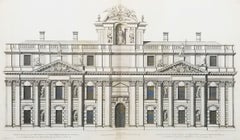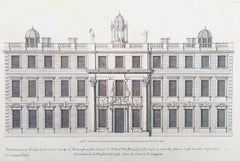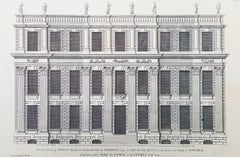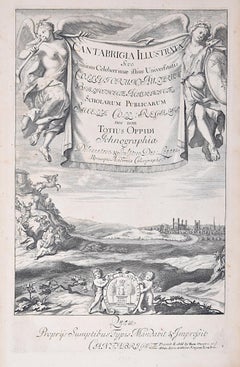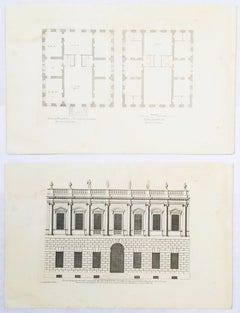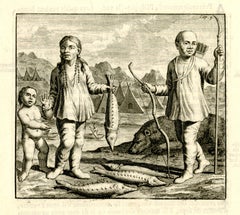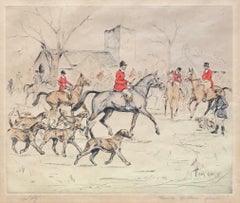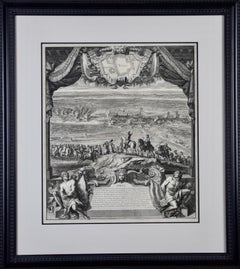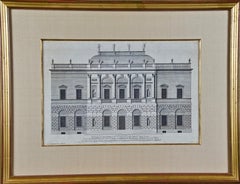1710s Landscape Prints
to
2
7
1
Overall Width
to
Overall Height
to
8
7
1
1
1
1,011
2,153
9,969
4,011
116
115
710
511
594
1,139
1,461
1,650
1,316
627
658
7
3
8
7
3
3
3
2
2
2
2
2
2
2
1
1
1
1
1
1
1
1
10
7
7
7
7
8
2
Period: 1710s
Royal Hospital att Greenwich to the River /// "Vitruvius Britannicus" Engraving
Located in Saint Augustine, FL
Artist: Colen Campbell (Scottish, 1676-1729)
Title: "Royal Hospital att Greenwich to the River" (Vol. 1, Plates 86, 87)
Portfolio: Vitruvius Britannicus; or The British Architect, Co...
Category
Old Masters 1710s Landscape Prints
Materials
Laid Paper, Engraving, Intaglio, Etching
Thorsby House in the County of Nottingham /// "Vitruvius Britannicus" Engraving
Located in Saint Augustine, FL
Artist: Colen Campbell (Scottish, 1676-1729)
Title: "Thorsby House in the County of Nottingham" (Vol. 1, Plate 91)
Portfolio: Vitruvius Britannicus; or The British Architect, Contain...
Category
Old Masters 1710s Landscape Prints
Materials
Laid Paper, Engraving, Etching, Intaglio
Powis House in Ormond Street London /// "Vitruvius Britannicus" Engraving
Located in Saint Augustine, FL
Artist: Colen Campbell (Scottish, 1676-1729)
Title: "Powis House in Ormond Street London" (Vol. 1, Plate 42)
Portfolio: Vitruvius Britannicus; or The British Architect, Containing th...
Category
Old Masters 1710s Landscape Prints
Materials
Laid Paper, Engraving, Etching, Intaglio
David Loggan Cambridge View Frontispiece Cantabrigia engraving 1715
By David Loggan
Located in London, GB
To see our other views of Oxford and Cambridge, scroll down to "More from this Seller" and below it click on "See all from this Seller" - or send us a message if you cannot find the ...
Category
Realist 1710s Landscape Prints
Materials
Engraving
Set of Two Engravings from Campbell's "Vitruvius Britannicus" /// Architecture
Located in Saint Augustine, FL
Artist: Colen Campbell (Scottish, 1676-1729)
Titles: "The Plan of this New Design to the Earl of Islay" (Vol. 1, Plate 53) and "This New Design to the Earl of Islay" (Vol. 1, Plate 5...
Category
Old Masters 1710s Landscape Prints
Materials
Laid Paper, Engraving, Etching, Intaglio
Ostiakes
By Cornelis de Bruijn
Located in Fairlawn, OH
Ostiakes
Engraving, 1718
From: Voyages de Corneille le Brun par la Moscovie, en Perse, et aux Indes Occidentales (French translation, 1718), Chapter XXI
The Ostyak are a member of an...
Category
Old Masters 1710s Landscape Prints
Materials
Engraving
St Peters Church at Rome /// "Vitruvius Britannicus" Architecture Engraving Art
Located in Saint Augustine, FL
Artist: Colen Campbell (Scottish, 1676-1729)
Title: "St Peters Church at Rome" (Vol. 1, Plate 6)
Portfolio: Vitruvius Britannicus; or The British Architect, Containing the Plans, Ele...
Category
Old Masters 1710s Landscape Prints
Materials
Laid Paper, Engraving, Etching, Intaglio
Set of Two Engravings from Campbell's "Vitruvius Britannicus" /// Architecture
Located in Saint Augustine, FL
Artist: Colen Campbell (Scottish, 1676-1729)
Titles: "Plan of the Principal Floor of Wilberry House" (Vol. 1, Plate 51) and "Wilberry House in the County of Wilt" (Vol. 1, Plate 52)
...
Category
Old Masters 1710s Landscape Prints
Materials
Laid Paper, Engraving, Etching, Intaglio
Set of Two Engravings from Campbell's "Vitruvius Britannicus" /// Architecture
Located in Saint Augustine, FL
Artist: Colen Campbell (Scottish, 1676-1729)
Titles: "The Plan of Lindsey House in Lincolns Inn Fields" (Vol. 1, Plate 49) and "Lindsey House in Lincolns Inn Fields" (Vol. 1, Plate 5...
Category
Old Masters 1710s Landscape Prints
Materials
Laid Paper, Engraving, Etching, Intaglio
Johannes Kip, The North Prospect of Gloster Cathedral (c.1716) Copper Engraving
By Johannes Kip
Located in London, GB
To see our other architectural drawings and engravings, scroll down to "More from this Seller" and below it click on "See all from this Seller" - or send us a message if you cannot ...
Category
Realist 1710s Landscape Prints
Materials
Engraving
Related Items
Hounds Gentlemen Please by Tom Carr - Engraving 26x31 cm
Located in Geneva, CH
Work on paper
Ed: 63/75
Category
Realist 1710s Landscape Prints
Materials
Engraving
$360 Sale Price
28% Off
H 10.24 in W 12.21 in D 0.08 in
Daniel Marot's The Siege of the Dutch Fortified City of Ypres by Louis XIV
By Daniel Marot
Located in Alamo, CA
"Ypres, Grand Ville Riche & Marchande" is an engraving and etching by Daniel Marot (le Vieux) (1661–1752). It depicts a view of the siege of the city of Ypres and its citadel on the left in the Spanish Netherlands by Louis XIV's troops. This battle took place between March 18 and March 25, 1678, as part of the Franco-Dutch War. Marot illustrated in great detail (best appreciated with magnification) the French attack on the strong pentagonal citadel on the extreme left, which had been built recently in anticipation of a French attack. The trenches built by the French approaching the town are seen on the right. King Louis XIV can be seen in the foreground surveying the battle mounted on his white horse, surrounded by his officers and troops.
The print is presented in an attractive ornate black wood frame with a cream-colored double mat with a black inner trim. It is glazed with plexiglas. The frame measures 25.38" x 22.63" x .88". The engraving, frame, mat and glazing are in excellent condition.
Artist: Daniel Marot (1661–1752) was also called "Le Vieux". He was the son of the famous architect, Jean Marot. Marot had diverse interests and talents. In addition to his art, he designed garden projects, architectural ornaments, furniture, and even upholstery. Marot as a Huguenot protestant was forced to leave France in 1685 following the revocation of the Edict of Nantes. He emigrated to Holland, where he worked for William of Orange (an arch enemy of his former employer Louis XIV). Marot was largely responsible for the interiors of Williams palace at the Loo. In 1694 he went Britain as William had married Queen Mary and he had become King William III of England. He later returned to Holland in about 1698 and died in the Hague in 1752. He left a lasting legacy on the decorative arts in the Netherlands, where his grand version of the Louis XIV style remained popular into the 1730s.
Historical Background: In October 1677, Mary Stuart, niece and possible successor of Charles II of England, married Louis XIV's arch enemy William III of Orange...
Category
Old Masters 1710s Landscape Prints
Materials
Engraving, Etching
$1,275
H 25.38 in W 22.63 in D 0.88 in
"A Dance in Otaheite" (Tahiti), Engraving from Captain Cook's 3rd Voyage
By John Webber
Located in Alamo, CA
"A Dance in Otaheite" (Tahiti) is an engraving created by William Sharp (1749-1824), from a drawing by John Webber (1752-1793), who was the artist on Captain James Cook's 3rd and final voyage of discovery. It is a plate in the atlas of "A Voyage to the Pacific Ocean Undertaken by the Command of His Majesty, for Making Discoveries in the Northern Hemisphere", the official British Admirality sanctioned journal published upon completion of the voyage in London in 1784 by Strahan & Cadell.
Two women and two men wearing ceremonial costumes, performing a dance outdoors standing on a mat. Three men are playing the drums in the background, in front of a thatched roof building. An audience of men are sitting on both sides of the stage. By the time Webber arrived in Tahiti, 'south sea' imagery had become familiar. Webber gave concentrated attention to dance. He had the opportunity to distinguish the Tahitian dance from the more formalized dancing of Tonga. Whereas they seem to have called to mind the more formal dances of antiquity, the Tahitian dancing aroused memories of peasant and folk dancing.
This engraving is professionally framed in Koa wood. Koa wood is legendary in Hawaii. Not only is this amazing wood native to Hawaii, but it is known for the deep rich colors and varied grain pattern. Koa has an honored heritage in Hawaii and is highly revered and sacred. The word “koa” means “warrior” in Hawaiian. The warriors of King Kamehameha the Great, created canoes and weapons from a wood plentiful on the Big Island of Hawaii. This wood became synonymous with the warriors themselves, and it became known as koa.
The print is in excellent condition.
There are three other engravings listed from the official journal of Captain Cook's 3rd voyage available that are presented in identical Koa wood frames and double mats (LU117324682432, LU117324684052, LU117324684062). They would make a wonderful grouping for a display of 2, 3 or 4 prints. A discount is available for a grouping depending on the number of items included.
Hawaii was discovered by Captain Cook during this voyage. Hawaii was originally called The Sandwich Islands in honor of The Earl of Sandwich...
Category
Realist 1710s Landscape Prints
Materials
Engraving
$2,375
H 21.75 in W 23.75 in D 0.88 in
The Windmill by François Vivares, after Rembrandt
Located in Middletown, NY
Engraving on cream laid paper, 8 x 5 7/8 inches (202 x 149 mm), trimmed at the platemark. Adhered at each corner to a small sheet of archival laid paper. Horizontal edge loss at the ...
Category
Old Masters 1710s Landscape Prints
Materials
Handmade Paper, Laid Paper, Etching
'Sister, A portrait of the Moon' , Signed Etching c2021
Located in Frome, Somerset
'Sister' , by contemporary printmaker and artist Rosie McLay (British)
Edition 59 of 75 in total, handmade etching by the artist.
Ink on paper layed on Dutch gold leaf.
Hand etched ...
Category
Realist 1710s Landscape Prints
Materials
Engraving
$613
H 17.72 in W 17.72 in D 1.19 in
The Last Supper, from The Passion of Christ
By Hendrick Goltzius
Located in Middletown, NY
Engraving on cream laid paper, 8 x 5 3/8 inches (203 x 137 mm), trimmed at the platemark. A fine impression with a Coat of Arms watermark. Second state, after the addition of the Frederick de Witt...
Category
Old Masters 1710s Landscape Prints
Materials
Laid Paper, Engraving
Canal with a large Boat and Bridge – after Rembrandt van Rijn
Located in Middletown, NY
Heliogravure on cream laid paper, 3 1/4 x 4 1/4 inches (80 x118 mm), thread margins. In good condition with a soft vertical crease and minor uniform toning. Printed early 19th centur...
Category
Old Masters 1710s Landscape Prints
Materials
Laid Paper, Photogravure
$400
H 3.15 in W 4.65 in
Ancient Roman Architecture: Original Framed 18th C. Etching by G. Piranesi
Located in Alamo, CA
"Veduta del Sepolcro della Famiglia Plauzia per la Strada Che Conduce da Roma a Tivoli vicino a Ponte Lugano" from "Le Antichità Romane" (Roman Antiquities), one of the most famous works by Piranesi. "Antichita" illustrates the tombs along the Appian Way...
Category
Old Masters 1710s Landscape Prints
Materials
Etching, Engraving, Drypoint
$3,875
H 24.38 in W 31.75 in D 0.75 in
The Beheading of the King of England; Enthauptung des Königs in England
Located in Middletown, NY
The execution of Charles I (1600-1649) at Whitehall, January 30th 1649, in front of the Banqueting House. The executioner holding the head of Charles up to the crowd below.
Engravin...
Category
Old Masters 1710s Landscape Prints
Materials
Laid Paper, Engraving
North and South America: An 18th Century Hand-colored Map by Johann Homann
Located in Alamo, CA
This early 18th century hand-colored copperplate map of North and South America entitled "Totius Americae Septentrionalis Et Meridionalis Novissima Repraesentatio" was created by Johann Baptist Homann and published in Nuremberg, Germany, between 1710 and 1731. The map details cities, forts, mountains, forests and lakes, as well as districts. There is a decorative cartouche in the lower left which depicts a volcano, scenes representing the people in their native costumes, as well as animals and plants of the Americas. A village is seen in the background on the left. A second smaller decorative cartouche in the upper right includes text and a series of allegorical figures. A large portion if the north central and western portions of North America is left without detail, because the region was largely unexplored at the time this map was created. The map also shows "Terra Esonis Incognita", representing a mythical continuous land bridge from North America to Asia, a northwest passage. The map preceded the French and...
Category
Old Masters 1710s Landscape Prints
Materials
Engraving
Christ and the Woman of Samaria Among Ruins by James Bretherton after Rembrandt
Located in Middletown, NY
Bretherton, James (After Rembrandt van Rijn).
Christ and the Woman of Samaria Among Ruins.
London: c 1775.
Etching on light cream laid paper, 4 3/4...
Category
Old Masters 1710s Landscape Prints
Materials
Handmade Paper, Etching, Laid Paper
$1,500
H 4.75 in W 4.13 in
Venus Lamenting over the Death of Adonis
Located in Middletown, NY
c. 1654. Etching with engraving on thin laid paper with an early and large unidentified watermark with a sundial and a many-pointed star, and an unidentified collector's stamp in the...
Category
Old Masters 1710s Landscape Prints
Materials
Handmade Paper, Engraving, Etching
Previously Available Items
18th C. Architectural Engraving from "Vitruvius Britannicus" by Colen Campbell
Located in Alamo, CA
"The Elevation of a New Design of my Own Invention in the Style of Inigo Jones, Is most humbly Inscribed to his Grace the Duke of Argyle & Knight of the most Noble Order of the Garter", plate 20 from Colen Campbell's first edition of "Vitruvius Britannicus...
Category
Other Art Style 1710s Landscape Prints
Materials
Engraving
H 17.25 in W 22.25 in D 0.75 in
